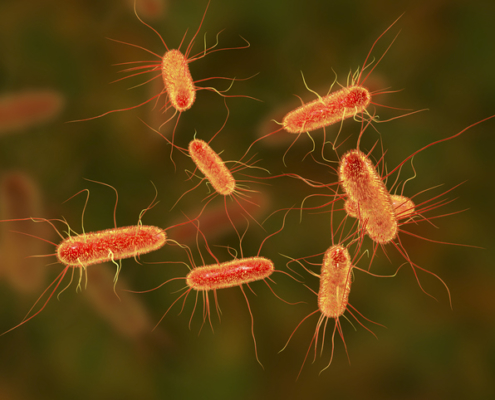A deadly E. coli outbreak includes five people in Oklahoma and 11 others in Arkansas, New York, Virginia, and Washington. The five-state E. coli O157:H7 outbreak is causing unusually severe infections including nine hospitalizations, three cases of hemolytic uremic syndrome (HUS), a form of kidney failure associated with E. coli infections, and one death, according to the Centers for Disease Control and Prevention (CDC).
Investigators have not yet determined the exact food source, but they do know that the outbreak strain was linked to a 2018 outbreak linked to romaine lettuce grown in Yuma, AZ that killed five people, and a deadly 2020 E. coli outbreak where leafy greens were a suspected source. Other outbreaks caused by this strain were linked to recreational water and ground beef.
The hospitalization rate for this outbreak is almost twice the average of 30 percent. Higher-than-average hospitalization rates were also associated with the 2018 Yuma-grown romaine outbreak and the 2020 E. coli outbreak where leafy greens were suspected.
This is the time of year that lettuce is grown in Yuma, but at this time the U.S. Food and Drug Administration (FDA) has not reported that it is currently investigating an E. coli outbreak. But last night, the U.S. Food and Drug Administration’s Food Safety and Inspection Service (USDA FSIS), which regulates meat and poultry, updated its Foodborne Outbreak Investigations page to include two new outbreaks, both with unknown sources. One is a Listeria outbreak, the other is an E. coli O157:H7 outbreak.
E. coli Lawyer Eric Hageman, whose law firm Pritzker Hageman has represented clients in every major E. coli outbreak in the U.S., said hospitalizations for E. coli cases can be difficult and expensive. The treatment for HUS, for example, includes transfusions, dialysis, plasma exchange, or kidney transplant.

Symptoms of an E. coli infection include abdominal cramps and diarrhea that can be bloody. Because the illnesses in this outbreak are so severe, the CDC is urging anyone with the following symptoms to seek immediate medical attention:
- Diarrhea and a fever higher than 102°F.
- Diarrhea for more than three days that is not improving
- Bloody diarrhea
- So much vomiting that you cannot keep liquids down
- Signs of dehydration, such as dry mouth or throat, feeling dizzy when you stand up, not urinating (peeing) much.
The 16 people sickened in this outbreak first developed symptoms of an E. coli infection on dates ranging from December 23, 2020, to January 7, 2021. Fourteen of the patients are female, two are male. They range in age from 10 to 95.
If you recently developed an E. coli O157:H7 infection from contaminated food and would like a free consultation with an experienced E. coli lawyer, please contact the Pritzker Hageman E. coli Legal Team. We have represented clients in every major E. coli outbreak in the U.S. including those who battled HUS and families who suffered the wrongful death of a loved one. You can reach us by calling 1-888-377-8900, sending a text to 612-261-0856, or by completing the form below. There is no obligation and we don’t get paid unless we win.
